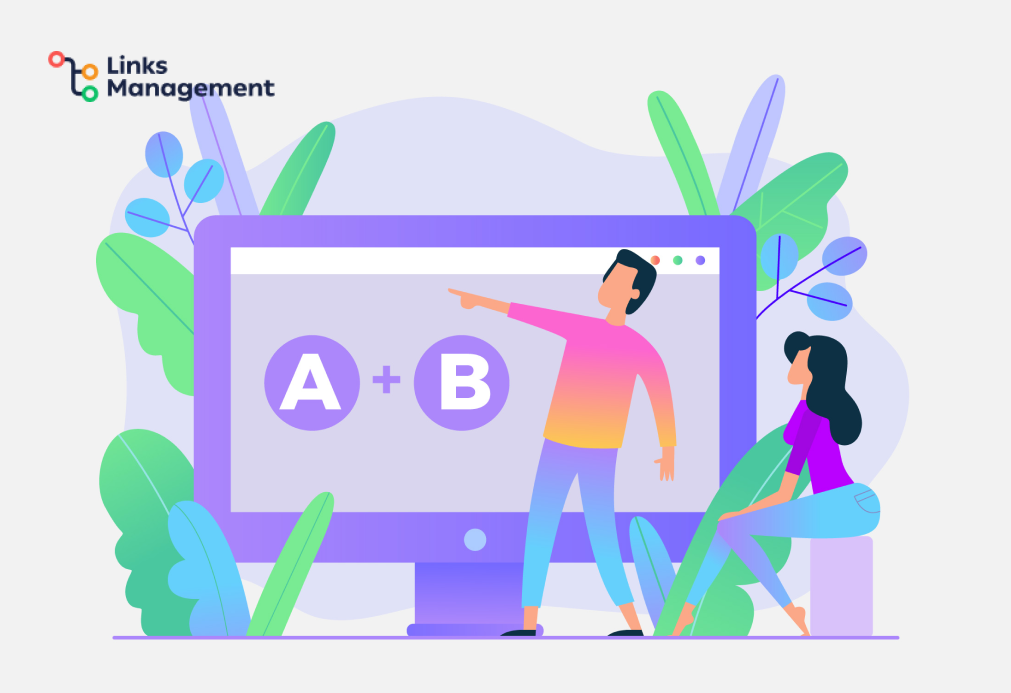A/B Testing for SEO: How to Conduct and Analyze Tests
SEO means dozens of variables, all influencing your website. This includes texts, keywords, page speed, media elements, etc. How do you understand which of them contribute to page’s popularity and which are problematic? That’s a common issue with SEO optimization. You simply don’t know what parts of your site need improvement (or don’t).

That’s when A/B testing in SEO hits the stage. Intended to check a particular aspect of your site, it helps to determine the weak and strong sides of the project. See how it works and explore the full guide to successful SEO analysis.
What Is A/B Testing in SEO?
The answer comes from the naming. This is a test, where a particular element is tested in two forms. For example, you write two texts for your website. All other elements are the same, but the texts are different on the two site versions. You invite users and see which text version works the best.
The same can be done for design, keywords, website map – basically, any element. A/B tasting doesn’t even come from SEO particularly. The method is used for targeted advertising, Google Ads, and all the marketing spheres. It can also be a superb way to analyze each aspect of optimization separately in SEO.
Who May Need It?
Basically, any business that has an Internet page. Talking precisely, SEO split testing is especially popular among websites with many variables:
- Businesses of all sizes. From small online shops to large platforms, everyone benefits from website optimization. And split testing helps to optimize each element perfectly.
- E-commerce stores. SEO AB testing is a must-have for such entrepreneurs. Even a tiny website element can increase sales and influence customers’ behavior. If you work with several world regions, this is especially important – clients’ habits and preferences are versatile.
- Content creators. Large-scale YouTubers use up to 100 preview variations for each video. This is no less important for website content: article illustrations, headings, and ad placement.
Should digital marketers be mentioned? In 2024, split testing is of enormous importance, and this trend will continue to rise. Since the number of Internet users is evolving, the race for their attention (and money, of course) is accelerating as well.
The Full Guide to A/B Testing: From Hypothesis to Practice
Treat any testing as a scientific project. A rocket scientist won’t randomly test ideas, and you shouldn’t as well. To see measurable results and make changes, ensure your A/B test matches three conditions:
- it tests a particular idea;
- it is measurable and gives figures;
- it gives insights that can be used practically.
Once you’re ready, see how professionals conduct the research. Follow those steps and do not miss any important details.
Select Pages for Testing
You won’t change the whole website to check one idea, right? Plus, comparing dozens of results is ineffective and confusing. Instead, choose two pages of similar content and visuals.

The closer pages are in terms of topic and audience, the better the results are. Here are some more requirements:
- ensure pages were created on the same day/month;
- they shouldn’t be brand new. Ensure they are AT LEAST 100 days old;
- they show similar traffic statistics;
- if your business is season-based, ensure pages have the same dynamics.
Basically, select two web pages with the same template, topic, and functions. Note that two pages are only one variant. If you have three-five page variations, select the according number of pages. However, don’t exceed this number, and never test several ideas at the same time.
Create a Hypothesis
“Which one is better” won’t work. You should select a particular aspect to compare. For product pages, these may be photos. For services or hotel booking, texts and SEO keywords are important. Finally, for two landing pages, compare block order. The hypothesis is a key to A/B testing SEO and the reason you conduct the research.
Sort and Create Variations
Now, it is time to implement the changes. See how professionals do it:
- Leave one “control” page. This one is a standard variation, used on the site before the test. Don’t change anything here. This page will show the average result and data to move from.
- Make one change per page. Don’t test text, design, and any other aspect at the same time. Choose one thing to test and change it on each experimental page.
The common mistake is using a page with the same content. Unlike a common opinion, this won’t work out and may hurt your SEO results. Two same pages confuse readers as well. Remember, it’s “same template”, not “same page”. Choose 3-5 similar goods (matching in terms of season, price, and audience) and use them as your variables.
Gather the Results
That’s a purely technical aspect – and the most confusing one. So, let’s sort it out step-by-step and answer the most common questions:
- How long to wait? Don’t analyze the result earlier than in 2–4 weeks. Before that, pages are optimized, and dynamics may vary. Only after a month, you can see clear dynamics.
- What data to use? The answer depends on your purpose and the business type. Usually, this includes the total number of clicks, time spent on the site, and the number of target actions (purchase, order, registration, etc.)
- Who can participate? Basically, everyone who visits the site. For platforms that have at least 10,000 organic sessions, this organic traffic is enough. If you’re a beginner, a SEO specialist may use the test group. These are real people who are your potential target audience. You can find them on test group platforms at a fair price.
- What analytical tools to use? Google Analytics is the basic tool for gathering and classifying your website traffic. Advanced marketers may use Ahrefs to get deeper insights.
This is only one variant, yet the most popular and efficient one. If you have a few thousand of organic traffic, examine the results and make changes faster. Large e-commerce projects and blogs examine traffic daily and change the variables as soon as insights are clear. You see, all this depends on your purpose, hypothesis, and the traffic.
Prioritizing the A/B Variables: What to Test First
This is another issue among beginning businesses. Each element, from button to picture, influences the SEO result. Testing them all blindly consumes the budget without particular results.
To decide, determine the business goal. If gaining more readers/viewers is the purpose, then test content. If you need more sales, work on product pages and factors that facilitate the client’s journey. In case you gather clients’ data for retargeting, work on lead form testing – place it at different parts of the page or change the CTA.

Additionally, think of improvement areas. If web users actively visit your page and don’t purchase the goods, the product pages may be a problem. In case people add items to the cart and don’t finish the order, some technical aspects may be an issue. Alternatively, the order form is too complicated. If people spend less time on the page, the text may be poorly written. And if you struggle with gaining visitors, test the meta tags of your page.
What Else Should You Know About A/B Tests
The industry constantly changes, and marketers find new approaches. If you want your split test to be effective in 2024, ensure you know the details:
- Understand split testing vs AB testing SEO. The terms usually replace each other. Both mean that two variables are compared to gain new insights. However, some marketers differentiate between those two. The A/B test just shows that we compare two (or more) variations of the page. Split testing, meanwhile, may mean the same amount of traffic on both pages. This, surely, requires artificial traffic increase – ads or test groups are used. Ensure you and your SEO specialist talk about the same things.
- Use metrics beyond clicks. Ensure you have access to the visit time and scroll depth. Also, implement user tracking that shows which particular buttons were clicked and how the customer behaves. This may show deep information about element placement and identify confusing design elements.
- Conduct the correlation analysis. Understand how different metrics interact. For example, many clicks and few purchases mean that there’s a problem with website content. A high purchase rate with few clicks shows that the website itself is good, but the search engine optimization is poor. Analyze metrics deeply.
- Include other specialists. Make sure the whole team gains insights from A/B testing impact on SEO. If you create test variations, attract copywriters. For design analysis, ensure the designer understands the mission and creates versatile page variations.
- Consider mobile optimization. In 2024, around half of all Internet users surf from mobile devices. Include this aspect in your SEO analysis. Ensure the website is adapted for small screens, and the structure is convenient for mobile devices. Looking good from a PC, a web page can confuse marketers and business owners. Always check your page’s mobile appearance before testing it.
Finally, combine the SEO A/B testing approach with other traffic sources. If you lack traffic, use social media ads or Google Ads to increase it. More people will give deeper insights. Plus, you’ll understand how different target audiences interact with the same variations.
Conclusion
One cannot underestimate how can split testing affect SEO. By testing a particular hypothesis, you receive effective insight with practical use. For this, an SEO specialist uses two or more variations of the same web page to compare particular elements – visuals, website structure, meta tags, keywords, and so on. If you struggle with achieving your website goals, such a thing may show what particular site parts require changes. Although it takes a while and needs constant monitoring, SEO tests are a powerful tool for your website optimization.
Enter URL & See What We Can Do Submit the form to get a detailed report, based on the comprehensive seo analysis.





